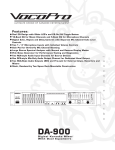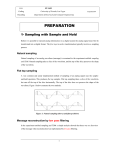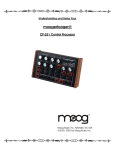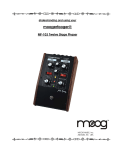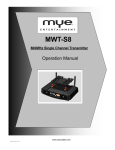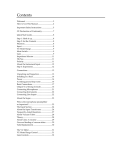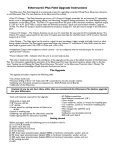Download Moog MF-102 Specifications
Transcript
Understanding and using your moogerfooger® MF-102 Ring Modulator Welcome to the world of moogerfooger® Analog Effects Modules! Your Model MF102 Ring Modulator is a rugged, professional-quality instrument, designed to be equally at home on stage or in the studio. Its great sound and classic effects come from the state-of-the-art all-analog circuitry, designed and built under Bob Moog's personal direction. Your MF-102 is a direct descendent of the original modular Moog™ synthesizers. It contains three complete modular functions,- a Ring Modulator, a voltage-controlled Carrier Oscillator, and a voltage-controlled dual-waveform Low Frequency Oscillator (LFO). All performance parameters are voltage-controllable, which means that you can use expression pedals, MIDI-to-CV converter, or any other source of control voltages to 'play' your MF-102. While you can use it on the floor as a conventional effects box, your MF-102 is much more versatile and its sound quality is higher than the single fixed function "stomp boxes" that you're probably accustomed to. You will find that your MF-102 is a deep musical resource. It will give you an amazing variety of new sounds and will become your creative companion as you explore its functions. The following pages will first tell you how to hook up your MF-102 and set the panel controls for the 'basic' setup. Next, we'll explain how the modular functions in your MF102 work. After that we'll go through the panel features and give you suggestions on how to use your MF-102 in specific applications. At the end of this booklet you'll find technical specifications, service and warranty information, and information about Moog Music. GETTING STARTED Here are some simple instructions on how you can quickly plug in and try out your MF102. 1. Unpack your MF-102. You can place it on a table or on the floor. We suggest that you place it on a table while you become familiar with its features. 2. Check that the power adaptor is designed to supply +9 volts and is rated at your country's standard power voltage (120 volts A.C. for the United States and Canada; 100 volts for Japan; and 220 volts A.C. for most other countries). Plug the power adaptor's cord into the MF-102's '+9V' jack. Then plug the power adaptor itself into a power voltage receptacle. Figure 1. Basic connections: Instrument to AUDIO IN, monitor amp to AUDIO OUT, and power adaptor to +9V. 3. Note that the BYPASS light is on. It will light up either red or green. Red indicates that the MF-102's ring modulator is off-line (bypassed), while green indicates that the ring modulator is on-line. Pressing the 'stomp switch' will toggle the BYPASS light between red and green. For now, leave the BYPASS light on red. Refer to Figure 1 for steps 4. and 5. 4. Connect an instrument cable from the MF-102 AUDIO OUT jack to a line-level input of your amp or mixer. Turn the volume control on your amp down but not off. 5. You can feed virtually any instrument-level or line-level signal through your MF-102. Examples are guitar, bass, keyboard, theremin, drum machine, or Effects Send output on your mixer. Connect an instrument cable from your signal source to the MF-102 AUDIO IN jack. Play your instrument (or turn on the signal source). Turn the DRIVE control clockwise until the LEVEL indicator lights up yellow most of the time. 6. The BYPASS light should still be red. Continuing to play your instrument, adjust the volume control of your monitor amp until the loudness is comfortable. Your instrument should sound clean and undistorted. 7. Now set the MF-102 panel controls as follows (See Figure 2): AMOUNT RATE MIX FREQUENCY Left Switch Right Switch 2 6.4 10 250 "Sine Wave" HI Figure 2 - Basic settings for becoming familiar with your MF-102. Press the stomp switch. The BYPASS light will now turn green. Play your instrument. Your instrument's signal is now going through the ring modulator. Listen to how the MF-102 affects the quality of your instrument's tone. You will hear a distinct vibrato. Note that the AMOUNT knob affects the strength of the vibrato and the RATE knob affects the vibrato's speed. 8. In the next section we'll explain exactly how a ring modulator works, what the carrier oscillator and LFO do, and how the controls work. For now, get a feel for the controls by experimenting with different settings. HOW A RING MODULATOR WORKS Let's start with some definitions. Please read this section carefully, as it will help you to understand the basic ideas underlying ring modulation. Sound is a vibration of the air. The speed of vibration is called the frequency. It is measured in Hertz (Hz). One Hz is one vibration per second. We hear vibrations from 20 Hz to 20,000 Hz. Musical sounds generally have many frequency components. They're called harmonics, or overtones, or partials. They are what give the sound its characteristic tone color, or timbre. We can represent a musical sound either as a waveform or as a spectrum. The waveform is a time graph of the actual shape of the vibration, while the spectrum shows how strong each of the sound's harmonics is. See Figure 3. Figure 3 - A musical sound can be represented as a waveform (top graph) or as a spectrum (bottom graph). The waveform of a single harmonic is called a sine wave. The spectrum of a sine wave is just a single line. Figure 4 shows the waveform and spectrum of a 500 Hz sine wave, while Figure 5 shows the waveform and spectrum of a 100 Hz sine wave. If you listen to a 500 Hz sine wave, you hear a pitch nearly an octave above middle C, with a mellow, muted quality, like a flute or a whistle. A 100 Hz sine wave also sounds mellow and muted, but its pitch is more than an octave below middle C. Figure 4 - Waveform and spectrum of a 500 Hz. sine wave. Figure 5 - Waveform and spectrum of a 100 Hz sine wave. Now we're ready to talk about what a ring modulator is. In electronics, modulation is any process in which one waveform is changed in response to the contour of another waveform. For instance, amplitude modulation is the shaping of the amplitude (strength) of one waveform by the contour of another waveform. The "AM" in "AM Radio" stands for amplitude modulation. An AM Radio signal coming from a transmitting tower consists of a very high frequency, called the carrier, which has been amplitudemodulated by an audio signal, called the program. Any analog signal can amplitude-modulate any other analog signal. A common example of amplitude modulation in electronic music is tremelo. Tremelo is the amplitude modulation of an instrument signal by a sine wave of a few Hz or so. Ring modulation is a special type of amplitude modulation. A ring modulator circuit has two inputs and one output. If a sine wave of one frequency is applied to the first input and a sine wave of another frequency is applied to the second input, neither of these input frequencies appears at the output. Instead, two new frequencies appear. One is equal to the sum of the two input frequencies, and the other is equal to the difference between the two frequencies. For instance, if the sine wave at the first input is 500 Hz and the sine wave at the second input is 100 Hz, then the output contains a 600 Hz sine wave and a 400 Hz sine wave. The resultant output waveform is complex. It looks like a 500 Hz sine wave that is amplitude modulated around its center axis by a 100 Hz sine wave (See Figure 6). When you listen to it, you hear two pitches: 400 Hz and 600 Hz. You do not hear either the 500 Hz or the 100 Hz input signals. Figure 6 - Waveform and spectrum of the result of ring-modulating a 500 Hz sine wave by a 100 Hz sine wave. What if the first input signal has many harmonics? In that case, the ring modulator output contains the sum and difference frquencies between all the harmonics of the first input, and the single frequency of the second input. Figures 7 and 8 show what happens when the first input is a 500 Hz square wave and the second input is a 100 Hz sine wave. Figure 7 shows the waveform and spectrum of a 500 Hz square wave. This waveform has only odd harmonics. The first harmonic (usually called the fundamental) is 500 Hz, the third harmonic is 1,500 Hz, the fifth harmonic is 2,500 Hz, and so on. This set of harmonics produces a tone that sounds bright and hollow. When this waveform is ring-modulated by a 100 Hz sine wave, the resultant spectrum contains components whose frequencies are 400 Hz, 600 Hz, 1,400 Hz, 1,600 Hz, 2,400 Hz, 2,600 Hz, and so on. Figure 8 shows the waveform and spectrum of the ring modulation of a 500 Hz square wave by a 100 Hz sine wave. Figure 7 - Waveform and spectrum of a 500 Hz. square wave Figure 8: Waveform and spectrum of a 500 Hz square wave ring-modulated by a 100 Hz sine wave. WHAT IS THE CARRIER OSCILLATOR? Your MF-102 contains a wide-range, voltage-controlled oscillator that produces a sinelike waveform. We call this the carrier oscillator because, like the carrier of an AM signal, it’s always there, ready to be modulated by any sound that you play. The carrier oscillator is connected to the second input of the ring modulator circuit through the bridging connection of the CARRIER IN jack on the rear panel. Thus, if you do not plug anything into this jack, then your MF-102’s carrier oscillator is automatically connected to the second input of the ring modulator. The carrier oscillator’s frequency is determined by the setting of the FREQUENCY knob and the LO-HI switch above it. The carrier oscillator frequency range extends from 0.6 Hz to 80 Hz on the LO setting of the switch, and from 30 Hz to 4 kHz on the HI setting of the switch. To hear the effect of changing the carrier oscillator frequency, first set up your MF-102 as follows: AMOUNT RATE MIX FREQUENCY Left Switch Right Switch 0 (doesn’t matter) 10 30/0.6 (doesn’t matter) LO Connect your instrument and monitor amp to your MF-102, set the stomp switch so the BYPASS light is green, and play a few simple, sustained notes. You will hear your instrument sound with a slow, smooth tremelo. Your instrument will get soft and loud twice for each cycle of the carrier oscillator. Now turn the FREQUENCY knob up one mark, and play the notes again. You will hear the tremelo get faster, Technically speaking, even at this low carrier frequency, your music signal is split into two sets of harmonics. However, the frequency difference between the two sets is so small that you really don’t hear them as difference pitches. Continue to turn up the FREQUENCY control, one mark at a time, playing a few simple, sustained notes at each mark. You will hear the tremelo get faster and faster. When the carrier frequency is above 20 Hz or so, the MF-102 output will no longer sound like a tremelo. Instead, your sound will begin to sound “rough” and “detuned” because the two sets of harmonics are far enough apart so you begin to hear them as two distinct sounds. When the FREQUENCY control is as far clockwise as it will go, turn it all the way back and set the switch on HI. Continue to play simple, sustained notes while turning the FREQUENCY control clockwise. Listen carefully. You will hear some pitches going up (the sum frequencies) and some going down (the difference frequencies). What happens when a difference frequency gets down to zero and you continue to turn the carrier frequency up? Technically speaking, the difference frequency then becomes negative. But as far as our ears are concerned, a negative frequency sounds just about the same as a positive frequency! So, as you continue to turn the carrier frequency up while you’re playing, you’ll hear the difference frequencies first go down, then start to come up, one by one. When the carrier frequency is up around 4 kHz, nearly all of the output sound will be very high pitched, even if you play low-pitched notes on your instrument. WHAT IS THE LFO, AND WHAT DOES IT DO? LFO stands for Low Frequency Oscillator. LFO’s are generally used to create slow modulations such as vibrato and tremelo. The LFO in your MF-102 is a wide-range, dual-waveform, voltage-controlled oscillator which frequency-modulates the carrier oscillator. This enables you to move the sum and difference frequencies toward and away from each other at speeds from one cycle every ten seconds, to 25 times a second, with either a square wave or a sine-like wave contour. To hear the effect of changing the carrier oscillator frequency, first set up your MF-102 as follows: AMOUNT RATE MIX FREQUENCY Left Switch Right Switch 4 0.1 10 120/2.5 sine waveform HI Connect your instrument and monitor amp to your MF-102, set the stomp switch so the BYPASS light is green, and play a few simple, sustained notes. You will hear the sum and difference frequencies slowly drifting apart, and then together, once every ten seconds or so. This is the result of the 0.1 Hz LFO triangular wave modulating the carrier oscillator frequency. The setting of the AMOUNT knob determines how much the carrier oscillator is being frequency-modulated, while the setting of the RATE knob varies the LFO frequency. Experiment with these two controls to hear the effect of the LFO over its entire range. Then set the left switch to square waveform to hear the difference between the two LFO waveforms. TOURING THE PANEL FEATURES The LFO Section Let's look at the LFO section first. The two control knobs are AMOUNT and RATE. In addition, there is a “square-sine” waveform switch. The LFO light shows the speed at which the LFO is oscillating. The AMOUNT knob determines the amount of LFO waveform that frequencymodulates the carrier oscillator. When the knob is counterclockwise, there is no frequency modulation by the LFO. When the knob is fully clockwise, the carrier oscillator is frequency-modulated over a range of three octaves. The RATE determines how fast the LFO oscillates. The knob spans the frequency range of 0.1 Hz (one cycle every ten seconds) to 25 Hz. The “square-sine” waveform switch selects either the square waveform or the sine-like waveform that the LFO produces. The square wave produces trill effects, whereas the sine waveform produces vibrato and siren effects. The LFO light is illuminated by the sine LFO waveform. You can use it to get a visual indication of the LFO’s speed. The Modulator Section The MIX knob, the FREQUENCY knob, and the LO-HI switch are all part of the Modulator section. The MIX knob crossfades from the direct (unmodulated) signal to the signal from the ring modulator output. You hear only the direct signal when the knob is counterclockwise, and only the ring-modulated signal when the knob is clockwise. You crossfade smoothly from one signal to the other as you turn the knob. The FREQUENCY knob and the LO-HI switch determine the frequency of the carrier oscillator. The FREQUENCY knob has two calibration ranges: 0.6 Hz to 80 Hz, and 30 Hz to 4 kHz. The LO-HI switch setting determines which range is on. Audio Input Level The DRIVE control and the LEVEL light are part of the audio input level circuitry. The DRIVE control adjusts the input gain. With this control you can set the right input gain for virtually any instrument or line-level signal source. Turn this control counterclockwise for strong input signals, and clockwise for weaker sound sources. The DRIVE control is always active, even when the MF-102 is in BYPASS mode. The LEVEL light tells how strong the input signal is after being adjusted by the DRIVE control. As the signal level increases, the light goes from off, to green, to yellow, and finally to red. Very weak signals do not light up this light at all. When the light is green, the signal is below the level that results in audible distortion. When the light is yellow, some low order distortion may be audible, giving the sound a subtle warm analog quality. When the signal is strong enough to drive the light into the red, the distortion at the output becomes stronger and more distinctly audible. Watch this light when you set the DRIVE control for the desired effect. Figure 9 - Block diagram of the MF-102, showing panel controls, switches, and jacks. (Pedal/control jacks are not shown, but perform the same functions as the control knobs.) EXPRESSION PEDALS AND VOLTAGE CONTROL You now know what each of the rotary control knobs does to the sound of the MF102. With the exception of DRIVE, each knob has an expression pedal/control input which duplicates its effect. This enables you to plug in up to four expression pedals to play the MF-102 with your feet as well as with your hands. The moogerfooger EP-1 Expression Pedal is designed for this purpose. Or you can use expression pedals with equivalent specifications. See the Technical Information section on Page 13 for more information on pedal specifications. When you plug an expression pedal into one of the pedal inputs on your MF-102, the pedal adds to the effect of the corresponding control. For example, let’s say that you plug an expression pedal into your MF-102’s MIX input. With the pedal all the way back, the mix of direct and ring-modulated sound is set by the MIX knob. Then, when you advance the pedal, the ring-modulated sound becomes stronger, just as if you turned the MIX knob up. So, a good rule to follow is: when you use an expression pedal, set the corresponding knob for the lowest value you want. Then, advancing the pedal increases that value. The expression pedal inputs can also be used as control signal inputs. This enables you to use your MF-102 with virtually any control signal source: modular analog synthesizers, MIDI-to-CV converters, etc. You will find information on interfacing your MF102 with external control signal sources in the Technical Information section on Page 13. In addition to the four expression pedal inputs, your MF-102 has an LFO output jack, a CARRIER OUT jack, and a CARRIER IN jack. The LFO and CARRIER OUT jacks may be used as control or audio signal sources to control other voltage-controlled devices, including other moogerfooger analog effects modules. The amplitude of the LFO output signal is independent of the setting of the AMOUNT control or pedal. The CARRIER IN jack enables you to feed any audio or control signal to the second input of the ring modulator circuit. When you plug a regular phone plug into the CARRIER IN jack, the MF-102’s carrier oscillator is disconnected from the ring modulator, and the signal from the phone plug goes in its place. You can use this feature to ring-modulate two outputs of your sound module to produce a new, ring-modulated timbre. To do this, assign a sound (let’s call it “the first sound”) that you want to modulate to one of your sound module’s outputs, and connect that output to the MF-102’s AUDIO IN jack. Then assign a second sound to another of your sound module’s outputs, and connect that output to the MF-102’s CARRIER IN jack. This second sound should be a sustained sound with a fairly simple waveform. The MF-102’s output will be a completely new sound, which you can mix with the first sound by turning the MIX control. Try setting the musical interval between the first and second sounds to an octave, fourth, or third, - or detune them just a tiny bit. You will be amazed at the variety of new, exciting timbres that you will be able to create! TECHNICAL INFORMATION NOTE: The following information is intended for use by people who understand analog electronic circuitry and have enough practical experience to interconnect sophisticated electronic equipment correctly. POWER: The MF-102 works satisfactorily on +9 to +15 volts DC and uses about 100 milliamperes of current. If your power adaptor shows up missing or inoperative, you can power your MF-102 from any other power adaptor with a +9 volt or +12 volt rating and with the same power connector. Figure 10 - The ‘+’ terminal must be at the center of the power connector. If you use a power source that was not supplied with the MF-102, be sure the voltage never exceeds +15 volts. Power voltages in excess of +15 volts may cause serious damage to the MF-102's circuit and your power source. PEDAL INPUTS: All pedal control input jacks are 1/4" tip-ring-sleeve phone jacks. The sleeves are grounded and the ring terminals are supplied with +5.7 volts which is current-limited to about 0.5 milliamperes. The tip terminals receive the variable voltages from the pedals. Figure 11 - Correct wiring of an expression pedal for the MF-102. An expression pedal for use with the MF-102 should contain a 50KW or 100KW potentiometer which is connected from the sleeve to the ring terminals. The potentiometer wiper is connected to the tip terminal. The pedal cable should be shielded, with the shield connected to the sleeve terminal. When connecting one or more pedal control input jacks to a source of external control voltage such as an analog synth or a MIDI-to-CV converter, you should use patch cords with tip-ring-sleeve phone plugs. The ring terminal on the plug should not be connected to anything, so that the MF-102's source of +5.7 volts is not shorted out. Figure 12 - Correct wiring of a tip-ring-sleeve plug for connecting a pedal control input to a source of external control voltage. Or, if you do not plan to use any expression pedals with your MF-102 but would like to apply control voltages to one or more pedal control inputs, you can use patch cords with regular two-conductor (tip-sleeve) phone plugs. These will short out the +5.7 volt supply to the ring contacts. This voltage is current-limited, so you won't burn anything out, - but no pedal will work in any of the pedal control jacks if a tip-sleeve plug is plugged into even one of the pedal jacks. Applying a varying voltage to the tip terminal of a pedal control input jack has the same effect as turning the corresponding knob. A voltage change of about 5 volts at the tip terminal is equivalent to turning the corresponding knob through its entire range. You can 'program' your MF-102 entirely from external control voltages, by turning all four control knobs (but not the DRIVE knob) counterclockwise, and feeding 0 to +5Volt programming voltages to the tips of the four pedal control input jacks. AUDIO PATH: Both the bypassed and the filtered signals go through voltagecontrolled amplifier circuits inside the MF-102. This is necessary to permit voltage-controlled mixing and smooth, clickless smitching. As a result, the MF102 will not pass an audio signal at all unless power is applied to it. Another result of this arrangement is that the strength of the audio output signal depends on the setting of the DRIVE control, even when the MF-102 is switched to BYPASS. The nominal audio output level with the LEVEL light in the yellow is about 0.5 volts RMS. LIMITED WARRANTY Moog Music warrants that its products will be free from defects in materials or workmanship, and shall conform to specifications current at the time of shipment, for a period of one year from date of purchase. During the one-year period, any defective products will be repaired or replaced, at Moog Music's option, on a return-to-factory basis. This Warranty covers defects that Moog Music determines are no fault of the user. RETURNING YOUR MF-101 FOR REPLACEMENT/REPAIR You must obtain prior approval and an RMA number from Moog Music before returning any product to us. Wrap your MF-101 carefully and pack it with the power adaptor in its original carton. The warranty will not be honored if the product is not properly packed. Then send it to Moog Music (UPS is recommended) with transportation and insurance charges paid. A reasonable cost for service and for materials and return freight will be charged to replace materials defective through the fault of the user, or for which the one year warranty period has expired. Transportation and insurance charges from Moog Music to your United States address, of products repaired or replaced under warranty, will be paid by Moog Music. . Moog Music Inc. 554C Riverside Drive Asheville, NC 28801 PHONE: (828) 251-0090 FAX: (828) 254-6233 EMAIL: [email protected] WEB ADDRESS: http://www.moogmusic.com MF-102 SPECIFICATIONS DESCRIPTION: Analog effects module incorporating three functions: ring modulator, carrier oscillator, and low-frequency modulating oscillator (LFO). FRONT PANEL FEATURES: FREQUENCY rotary control, which varies the carrier frequency over a seven-octave range. RATE rotary control, which varies the LFO's frequency from 0.1 Hz to 25 Hz. LFO AMOUNT rotary control, which adjusts the amount that the LFO output sweeps the carrier oscillator. MIX rotary control, which crossfades continuously from unmodulated to modulated audio. DRIVE rotary control, which adjusts the gain of the audio input. SQUARE-SINE rocker switch, which chooses between square and sine-like LFO waveforms. LO-HI rocker switch, which chooses between the low frequency carrier range (0.6 Hz to 80 Hz) and the high frequency carrier range (30 Hz to 4,000 Hz). LEVEL, a three-color LED that is used to set the DRIVE control. LFO, a LED that indicates the LFO rate. BYPASS, a two-color indicator LED that tells whether the filter is on or bypassed. ON/BYPASS, a rugged, smooth-acting 'stomp switch'. JACK PANEL FEATURES AUDIO IN 1/4" phone jack - accepts any instrument-level or line-level audio signal from 16 dBm to +4 dbm. Input impedance is 1 megohm. AUDIO OUT 1/4" phone jack - -4 dBm nominal output level. Output impedance is 600 ohms. FREQUENCY, RATE, LFO AMOUNT, MIX, all of which are stereo 1/4" jacks that accept moogerfooger EP1 (or equivalent) expression pedals, or control voltages from twocircuit or three-circuit 1/4" jacks. CARRIER IN - provides a means of applying an external –4 dBm (0.5 volt RMS) signal to the ring modulator, in place of the carrier oscillator. Input impedance is 1 megohm. LFO OUT jack - delivers the LFO voltage (±1.5 volts) for use by other voltage-controlled devices. Output impedance is 600 ohms. CARRIER OUT jack - delivers the carrier signal (±1.25 volts) for use by other devices. Output impedance is 600 ohms. GENERAL SPECIFICATIONS CASE: Black panel with hardwood sides - classic analog appearance. DIMENSIONS: 9" x 6" x 2-1/2" NET WEIGHT: 2 lb. SHIPPING WEIGHT: 4 lb, including power adaptor and instruction manual. POWER REQUIREMENTS: +9 to +15 volts DC. Nominal current is 100 milliamperes. MOOG MUSIC Inc. 554C RIVERSIDE DRIVE ASHEVILLE, NC 28801 Phone: (828) 251 0090 FAX: (828) 254 6233 EMAIL: [email protected] WEB SITE: http://www.moogmusic.com Entire Contents ©1998, 2003 by Moog Music Inc















